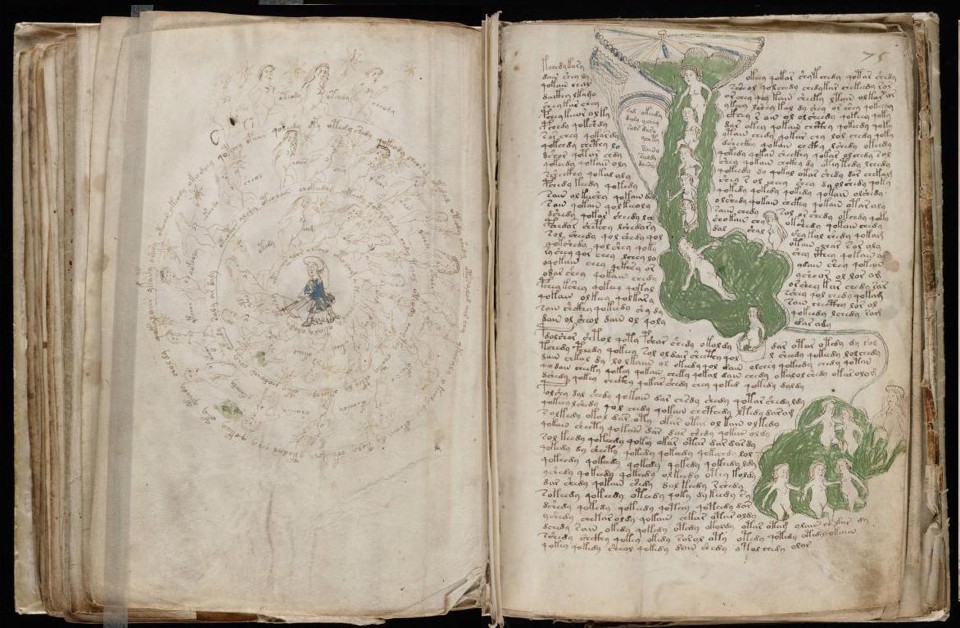
In Yale University’s Beinecke Rare Book and Manuscript Library, there’s an ancient text, bound in vellum, that’s catalogued under the call number MS 408. It’s unique in that no one can translate it because the hand-written script is either a code or an unknown language.
It’s known as the Voynich Manuscript, named after Wilfrid Voynich, a Polish book dealer who purchased it in 1912. The manuscript was carbon-dated to the early 15th century (1404-1438) and originated in Central Europe, possibly northern Italy. Besides the unusual script, it features drawings of flora, astrological charts and naked women lounging in pools of green water. From the images alone, we might assume, or at least suspect, that the manuscript is a secret text for women’s health involving herbal remedies. But why secret? Maybe it’s about herbal concoctions for preventing or aborting pregnancy, issues that remain hot-button topics today, at least for some people.
I read about this manuscript years ago and remember that cryptographers had studied it for decades, but it remained an unsolved mystery. I was reminded of the manuscript recently when I noticed a You Tube video by Terrence McKenna about it. McKenna, who died in 2000, thought that the 270-page manuscript was written by the Elizabethan mystic John Dee. Dee, who was the queen’s astrologer, was known to have written at least one other coded script and he lived in the decades when the manuscript was created. However, he didn’t live in Central Europe where the manuscript supposedly originated.
After taking a brief look at McKenna’s commentary, I did an internet search for the Voynich Manuscript and was surprised to find that there was new and recently published research about it. In fact, The Atlantic had published an article in September 2017–a couple of months ago—and supposedly a scholar had finally solved the enigmatic script.
The Atlantic’s article describes the manuscript as being “…full of astrological charts, strange plants, naked ladies bathing in green liquid, and, most famously, an indecipherable script that has eluded cryptographers to this day.
It was based on another article that came out the same week, published in the prestigious Times Literary Supplement as its cover story – a “solution” for the Voynich manuscript.
https://www.the-tls.co.uk/articles/public/voynich-manuscript-solution/
The article by Nicholas Gibbs suggests the manuscript is a medieval women’s-health manual copied from several older sources. And the cipher is no cipher at all, but simply abbreviations that, once decoded, turn out to be medicinal recipes. But is this really a solution or is it deciphering by way of the illustrations, as I mentioned?
Apparently, Gibbs was able to translate a couple of lines near the beginning. But medieval scholars, cryptographers and amateur sleuths, interestingly, were not impressed. They’ve seen it before with earlier failed attempts to solve the mystery.
“The summary in the TLS is really too short to provide any serious analysis,” René Zandbergen wrote in an email to The Atlantic. Zandbergen is a long-time researcher of the manuscript and runs a web site, Voynich.nu. Scholars say that not much is new in the TLS article and what is new appears to be incorrect.
When Lisa Fagin Davis, executive director of the Medieval Academy of America, was a doctoral student at Yale—where the Voynich Manuscript is housed—she read dozens of theories as part of her job. “If they (the Times Literary Supplement) had simply sent to it to the Beinecke Library, they would have rebutted it in a heartbeat,” she told The Atlantic.
As with all good mysteries, the Voynich Manuscript remains an enigma after 500 years, and so we still don’t know what exactly those naked women were doing in the green waters.








One of the things that happened during the witch trials, which were extensive throughout Europe, was that female herbalists and healers were regarded as witches, and could be burned for practicing. After the Inquisition females were prohibited from practicing any kind of medicine. Perhaps it was an attempt to preserve folk healing remedies, especially for women?
Good point!
Indy dealt with the Voynich manuscript in Indiana Jones and the Philosopher’s Stone – one of the best non-MacGregor Indy novels. 🙂
Interesting! I hope they do discover what it was written for, and what it’s about. You find the most fascinating things for me to ponder! 🙂
Rob found this one!